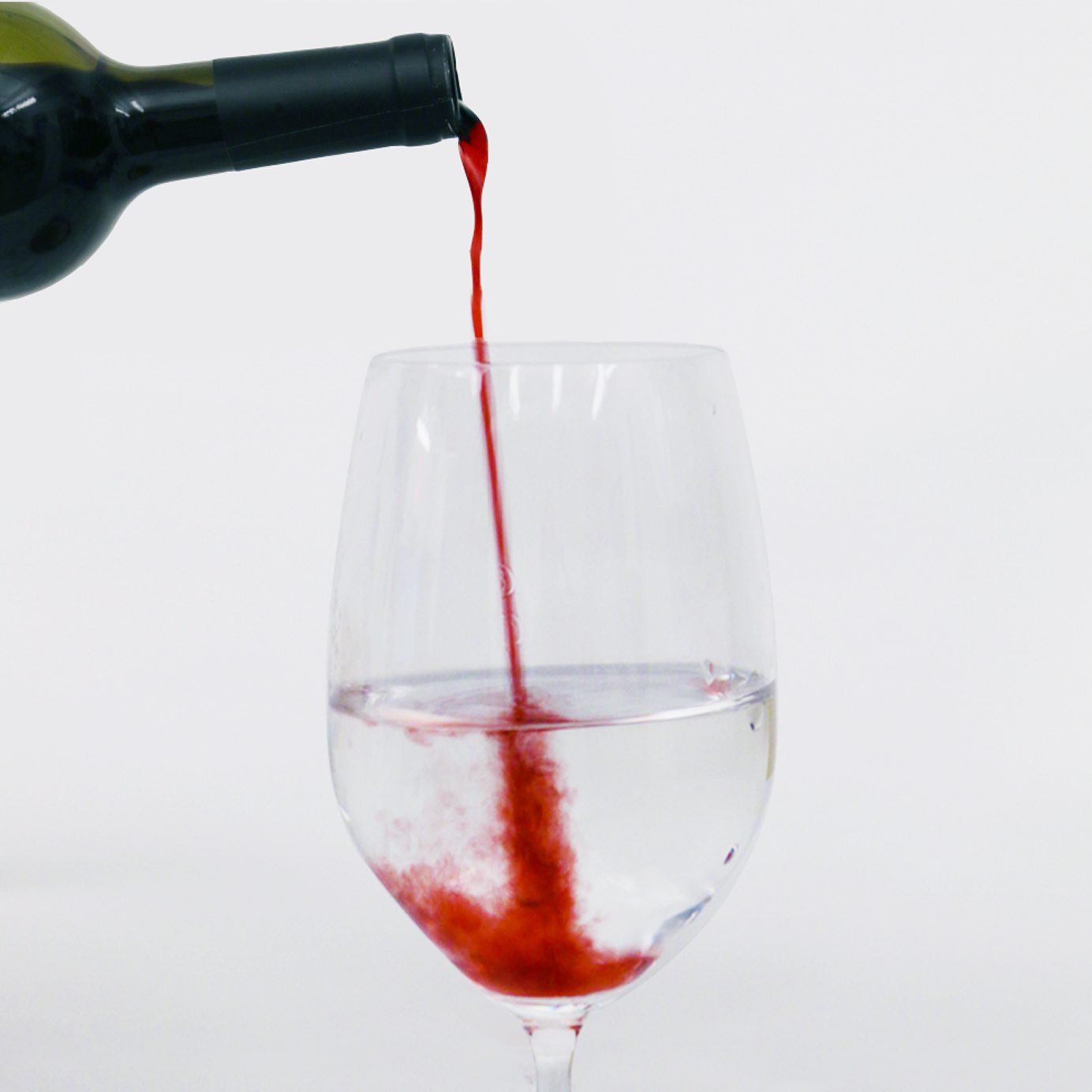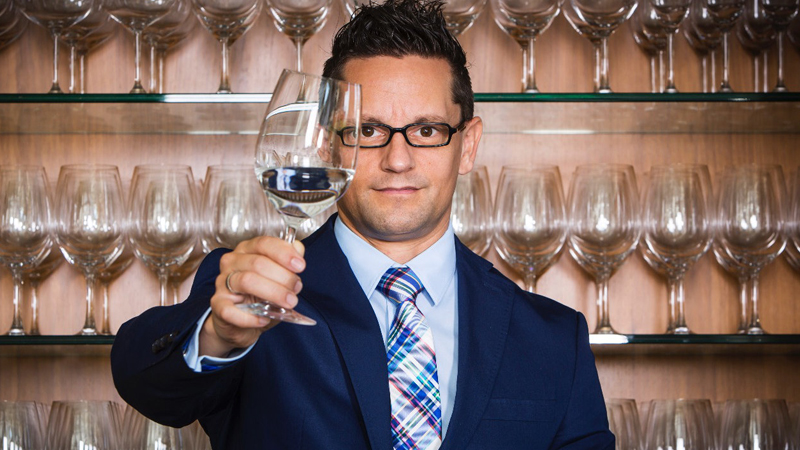Like many in the hospitality industry, German sommelier Martin Riese aims to ensure each and every one of his guests experiences ideal pairings during their meal. Only Riese is just as concerned with pairing water as he is with wine.
“In a restaurant, food is like your leading actor,” the 41-year-old sommelier says. Just as all leading actors benefit from a good support cast, well-prepared food deserves a worthy wine pairing. “Water, in my belief, is a supporting actor as well,” he says.
Riese is one of just a handful of certified water sommeliers in the U.S. He wants us to start viewing the beverage as so much more than just still or sparkling, and instead see it as a remarkable tool with the power to transform wine.
Based in L.A. since 2011, Riese now works for the Patina restaurant group. He creates special water menus for the group’s different locations, and offers wine and water pairings for guests at the flagship Patina restaurant in downtown L.A.
Speaking in a thick, amiable German accent, Riese describes water with the passion and conviction of a wine lover eulogizing first-growth Bordeaux. He handles it like wine, too, storing bottles of the restaurant’s most expensive offering — a $150 Norwegian “Svalbardi” glacial water — in a temperature-controlled wine cellar alongside premium bottles of Burgundy.
Riese first considered the idea of offering a mineral water menu in restaurants in 2005, while working at Berlin’s Michelin-starred First Floor. He described the moment he came to the realization in Eater in 2015:
“One night a guest came up to me and said, ‘So Martin, you have over 1,500 different wine labels but just one water brand. I do not like the taste of that water, what else can you offer me?’ I looked at him and realized that in the restaurant business it’s all about options. We offer a selection of liquors, beers, and wines, but when it comes to water, it’s mostly just sparkling, flat, or tap. Not even the water brand is given. It occurred to me that we have to give people options when it comes to the healthiest beverage on this planet and thus I created my first water menu.”
*
The subtle taste profile of different mineral waters is determined by the types and concentrations of minerals they contain. The total amount is referred to as the total dissolved solids (TDS) value, measured in milligrams per liter (mg/l). While TDS values represent all minerals present, those that affect flavor and mouthfeel most significantly are sodium, calcium, and magnesium.
Natural mineral water starts its life as rain. After slowly soaking through the ground, it is filtered by an underground layer of permeable rock called an aquifer, which imparts a unique flavor and mineral content.
Just like wine, the concept of terroir can be applied to water — its character simultaneously reflects the rocks and soil present in a certain location, as well as the amount of rainfall over a time period. Higher-than-average rainfall will see a drop in mineral concentration, as the increased volume filters through the different layers faster, picking up fewer minerals.
Glacial waters have “super low” TDS levels (less than 50 mg/l) because they don’t pass through any soil or rock. They’re smooth on the palate and share many characteristics with pure rainwater.
Waters with “medium” minerality (250 to 800 mg/l TDS) start producing interesting nuances. Those with high proportions of magnesium can taste slightly bitter, Riese says, while calcium imparts a metallic flavor. Sodium, rather unsurprisingly, adds saltiness. As TDS levels increase to “high” (800 to 1,500 mg/l), and “very high” (1,500-plus mg/l), waters become ever more complex with challenging flavors, including sulphur and even slightly spicy notes.
As a general rule, Riese advises against pairing sparkling mineral waters with wine because they can easily overpower. While there are some naturally sparkling mineral waters that have a fine mousse to match vintage champagne — Chateldon, for example — in many instances, waters are artificially carbonated with large and aggressive bubbles.
Sparkling water can also increase a wine’s perceived acidity. This is unrelated to the water’s pH, and is instead the effect of carbonation on the palate. When you pair carbonated waters with wines like Sauvignon Blanc or Riesling, the wines’ natural acidity becomes even more intense, subjugating fruit and “mineral” flavors (more on these later).
Carbonation can also mask the complexity of high-level TDS waters. For waters like Gerolsteiner, with a staggering 2,527 mg/l TDS, this can actually be useful. Without effervescence, the challenging flavors of these waters might be a step too far for most to enjoy.
One category of wines that Riese does feel benefits from a sparkling water pairing is sweet wines, due to their viscosity and heavy concentration of complex fruit flavors. “Badoit (TDS of 1,200) is great for sweet wines,” Riese says. “The richness and sweetness of the wine’s concentrated fruit will be balanced by the minerality of the water, and the medium carbonation level cuts through the thick texture of the wine.”
The key to matching still waters with wine is very similar to food and wine pairings. Some pairings succeed by layering contrasting characteristics on top of one another — just like with carbonated Badoit and sweet wines. Conversely, if you pair salty waters, like Vichy Catalan, with acidic wines like Albariño, their contrasting flavors clash.
Water can also be used to smooth out some wines’ more extreme characteristics. A smooth mineral water like Fiji (222 mg/l TDS), acts as a kind of blanket when paired with highly acidic wine, lessening perceived acidity and providing a platform for fruit flavors to shine.
Tannins are a major consideration when pairing water with red wines. Sparkling water, Riese says, will overemphasize tannins and all flavor will be lost. Waters with medium-range TDS, such as Evian (345 mg/l), are the best pairings for tannic Bordeaux-style red wines. The smooth character of Fiji, too, can be used to balance out tannic reds, Riese says.
*
Successful wine and water pairings are as subjective as anything involving taste and perception. Different people enjoy different flavors, and certain drinkers may be more attuned to bitterness, sweetness, and so on.
Minerality is arguably the most contested flavor in wine tasting — and with good reason. Scientists agree that, even though there are plenty of minerals in vineyard soils, most are tasteless; and, in any case, vine roots are incapable of absorbing them directly. It is common practice for wine professionals to describe varieties like Riesling as having pronounced mineral notes but, scientifically speaking, the aromas or flavors they are describing do not come from minerals.
As such the term means different things to different wine tasters. If you ask 10, 20, or even 50 leading wine industry experts about the term “minerality,” each will give a slightly different definition.
“I almost avoid using the word because it’s so nebulous, and people use it so indiscriminately,” Jordan Ross says. “I think it’s lost its value.”
Like many in the wine industry, Jordan Ross was working in another career — a stockbroker on Wall Street, in his case — when the pull of the vine became too strong to resist. He is now an importer and has lectured and written extensively on minerality. His report, Minerality: Rigorous or Romantic, in Practical Winery & Vineyard Journal, remains one of the most in-depth explorations of the topic.
There are indeed traces of minerals in wine, but they appear in even smaller quantities than in mineral water. Since these tiny amounts of subtle-tasting minerals are competing against the concentrated and complicated flavors in wine, the mineral quality people perceive when tasting wines simply has to come from somewhere else.
In that way, minerality is akin to tasting notes like “blackberry,” “tobacco,” or “chocolate.” None of those ingredients are actually present in wine, but that doesn’t mean you can’t taste or smell or perceive them.
*
When Riese describes different styles of mineral water, the brands he mentions are affordable supermarket and deli stables. Unlike wine, one does not have to visit a specialty shop or spend a lot of money to try a wide range of styles of water.
The only bottles you should absolutely not be buying, he says, are purified or distilled waters from brands like Smart Water, Aquafina, and Divani. Essentially just distilled tap water, these waters contain zero TDS and actually remove minerals as they pass through your body. “Mother Nature does not know the concept of distilled water,” Riese says.
To test the different pairing suggestions, we picked up contrasting styles of water, from low to high TDS levels, in both still and sparkling form. We tasted them alongside a high-mineral Sancerre and a tannic Bordeaux-style red blend to see how the different pairings performed.
With the Sancerre, lower TDS waters like Saratoga (73 mg/l) seemed to overemphasize the wine’s fruit notes and acidity, and the minerality almost disappeared. Waters with medium TDS levels, such as Evian, neutralized the Sancerre’s fruit character, and all that could be tasted were salty, mineral notes, as well as a choking bitterness. This sensation was further pronounced with carbonated high-TDS waters, including San Pellegrino and Gerolsteiner.
The undisputed best pairing was Fiji, which brightened up the wine without altering any of its fundamental characteristics. The effect was like adding an Instagram filter to a photo you already thought was brilliant.
Alongside the Bordeaux blend, the lower TDS Saratoga started well, but then fruit character dropped off, leaving a lingering salinity. When paired with the complex carbonated waters, as Riese suggested, all flavor was lost and the wines turned into tannin bombs.
Our winner here was the medium-minerality Evian. Even our most skeptical tasters felt it transformed the $20 bottle into something that tasted more premium, pronouncing fruit notes but maintaining balance with tannic structure.
*
Admittedly, the idea of a bottled water tasting does smack of the emperor’s new clothes. Our panel did, however, find noticeable differences, not just among the mineral waters but with the ways they affected our perceptions of the wines.
It’s important to remember that minerality is subjective. Yes, it’s quantifiable in the form of TDS in mineral water, but the intensity with which these flavors are picked up by our palates varies widely from person to person. Perhaps the key is not to try to find what others are tasting but, instead, to try to better understand our individual experiences.
One of my colleagues preferred the pronounced dry, chalky taste of Sancerre paired with Evian, even as she felt it was “a bit out of balance.” You might also like that better. Or you might think that all of this is hogwash and go on drinking your fine wine with your sparkling Gerolsteiner. That’s fine, too.
What I found from exploring water pairings is that they made me reconsider minerality in wine, as well as change the way I think about water — never again will I think of it as a flavorless beverage. For those seeking to identify or fine-tune their perceptions of minerality in wines, tasting a selection of supermarket waters alongside a Sancerre or Riesling described as having “minerality” could be a useful exercise.
As Post-Impressionist French artist Cézanne once said, “Painting from nature is not copying the object; it is realizing one’s sensations.”

